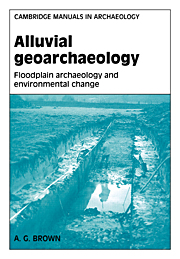Book contents
- Frontmatter
- Contents
- List of illustrations
- List of tables
- Preface
- Acknowledgements
- Introduction and the example of the Nile
- PART I PRINCIPLES
- 1 Floodplain evolution
- 2 Alluvial environments over time
- 3 Interpreting floodplain sediments and soils
- 4 Floodplain ecology, archaeobotany and archaeozoology
- PART II APPLICATION
- APPENDICES
- References
- Subject Index
- Index of rivers and sites
3 - Interpreting floodplain sediments and soils
Published online by Cambridge University Press: 03 December 2009
- Frontmatter
- Contents
- List of illustrations
- List of tables
- Preface
- Acknowledgements
- Introduction and the example of the Nile
- PART I PRINCIPLES
- 1 Floodplain evolution
- 2 Alluvial environments over time
- 3 Interpreting floodplain sediments and soils
- 4 Floodplain ecology, archaeobotany and archaeozoology
- PART II APPLICATION
- APPENDICES
- References
- Subject Index
- Index of rivers and sites
Summary
Floodplain evolution reflects the prevailing environmental conditions and changes in those conditions. This chapter illustrates how the sediments and soils which form floodplain stratigraphies can be used to reconstruct past environmental conditions.
River morphology and sedimentation
Our ability to infer past conditions from floodplain sediments comes from the analysis of contemporary rivers and their sedimentation, i.e. the present is the key to the past. It is necessary therefore to understand the general morphology (pattern and shape) of rivers and processes that operate in them. Rivers in all climatic zones vary from headwaters to outlet owing to the changing volumes of water and sediment supplied to them and the local geology and slope over which they run. In small mountainous headwaters bedrock and coarse bed material dominate the channel, resulting in steps, pools, cascades and waterfalls (Church, 1992). Alternatively in low-relief areas headwaters may be almost imperceptible wet patches (flushes), springs or field drains with cohesive peaty or clay-rich beds and banks. In larger mountain and piedmont zone rivers channel bar accumulations are important stores for bed material (Church and Jones, 1982). In these channels the pool and riffle is the major morphological feature (Figure 3.1). It is believed that the pool is created by scour during floods but under normal and low flows the velocity of water flow is faster over the shallow riffles and water is slower in the pools (Keller, 1971 and later discussion).
- Type
- Chapter
- Information
- Alluvial GeoarchaeologyFloodplain Archaeology and Environmental Change, pp. 63 - 103Publisher: Cambridge University PressPrint publication year: 1997



